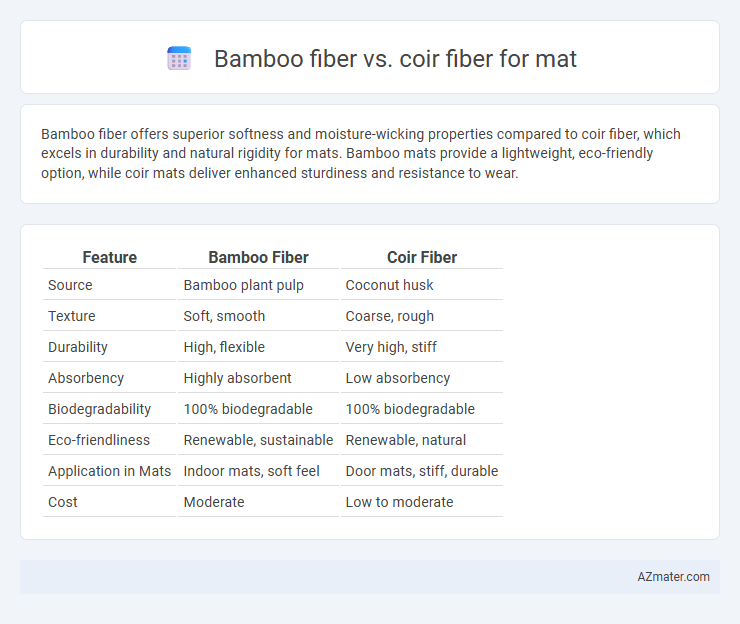Bamboo fiber offers superior softness and moisture-wicking properties compared to coir fiber, which excels in durability and natural rigidity for mats. Bamboo mats provide a lightweight, eco-friendly option, while coir mats deliver enhanced sturdiness and resistance to wear.
Table of Comparison
| Feature | Bamboo Fiber | Coir Fiber |
|---|---|---|
| Source | Bamboo plant pulp | Coconut husk |
| Texture | Soft, smooth | Coarse, rough |
| Durability | High, flexible | Very high, stiff |
| Absorbency | Highly absorbent | Low absorbency |
| Biodegradability | 100% biodegradable | 100% biodegradable |
| Eco-friendliness | Renewable, sustainable | Renewable, natural |
| Application in Mats | Indoor mats, soft feel | Door mats, stiff, durable |
| Cost | Moderate | Low to moderate |
Introduction to Bamboo Fiber and Coir Fiber
Bamboo fiber, derived from the pulp of bamboo grass, is renowned for its softness, durability, and natural antibacterial properties, making it an eco-friendly choice for mats with a smooth texture and moisture-wicking capabilities. Coir fiber, obtained from the outer husk of coconut shells, is valued for its coarse, tough texture and excellent resilience, providing superior durability and water resistance in mats designed for heavy-duty use. Both fibers offer sustainable alternatives in mat manufacturing, balancing comfort, longevity, and environmental impact.
Source and Sustainability of Bamboo and Coir
Bamboo fiber is derived from the fast-growing bamboo plant, which can regenerate without replanting, making it a highly renewable and sustainable resource. Coir fiber is extracted from the outer husk of coconut shells, a natural byproduct of coconut harvesting, promoting waste utilization and reducing environmental impact. Both fibers offer eco-friendly alternatives, but bamboo's rapid growth cycle and minimal pesticide use enhance its sustainability advantage over coir.
Physical Properties: Texture, Strength, and Durability
Bamboo fiber mats offer a smooth, silky texture with high tensile strength, making them resistant to wear and tear, while coir fiber mats are rougher with a coarse texture that provides excellent grip and natural cushioning. Bamboo fibers boast superior durability due to their resistance to moisture and microbial attacks, whereas coir fibers exhibit strong resilience against environmental stress but may degrade faster in prolonged wet conditions. The combination of bamboo's sleek finish and toughness contrasts with coir's robust, fibrous nature ideal for heavy-duty, abrasive surfaces.
Comfort and User Experience
Bamboo fiber mats offer superior softness, breathability, and moisture-wicking properties, enhancing overall comfort and reducing skin irritation during prolonged use. Coir fiber mats provide excellent durability and natural firmness, supporting better posture but may feel rougher against the skin. Users seeking a balance between comfort and eco-friendliness often prefer bamboo fiber mats for everyday use, while coir fiber mats suit outdoor or high-traffic areas requiring sturdiness.
Absorbency and Moisture Management
Bamboo fiber exhibits superior absorbency and moisture-wicking properties compared to coir fiber, making it ideal for mats that require efficient moisture management. Bamboo fibers rapidly absorb water while allowing quick evaporation, reducing dampness and preventing mold growth. Coir fiber, derived from coconut husks, is more rigid and less absorbent, often retaining moisture longer, which can lead to slower drying times and increased mildew risk.
Eco-Friendliness and Biodegradability
Bamboo fiber and coir fiber both offer eco-friendly alternatives for mat production, with bamboo fiber being highly sustainable due to its rapid growth rate and minimal need for pesticides, while coir fiber is derived from coconut husks, a renewable waste product. Bamboo fiber mats are biodegradable within a few months under natural conditions, whereas coir fiber mats decompose more slowly but still break down completely without leaving harmful residues. The choice between these fibers depends on balancing the faster renewability of bamboo with the traditional durability and waste-utilization benefits of coir.
Cost Comparison: Bamboo vs Coir Mats
Bamboo fiber mats generally cost more than coir fiber mats due to the higher processing expenses and sustainable harvesting methods involved in bamboo production. Coir mats, derived from coconut husk fibers, are typically more affordable and widely available, making them a cost-effective choice for budget-conscious consumers. While bamboo mats offer durability and eco-friendliness, coir mats present a lower upfront cost with reasonable durability for everyday use.
Maintenance and Cleaning Requirements
Bamboo fiber mats require minimal maintenance due to their natural antibacterial properties and resistance to moisture, allowing easy cleaning with mild soap and water. Coir fiber mats demand more frequent cleaning as they tend to trap dirt and retain moisture, which can lead to mold growth if not dried properly. Regular vacuuming and thorough drying are essential for coir mats to maintain durability and hygiene.
Applications and Versatility
Bamboo fiber mats excel in indoor applications due to their softness, natural antibacterial properties, and moisture-wicking ability, making them ideal for yoga mats, bath mats, and upholstery. Coir fiber mats are highly durable and water-resistant, suited for outdoor use such as door mats, garden mats, and erosion control mats, providing excellent slip resistance and longevity. The versatility of bamboo fiber lies in its eco-friendly, lightweight nature for softer, comfortable products, while coir fiber's coarse texture and robustness cater to heavy-duty, weather-exposed applications.
Final Verdict: Choosing the Right Mat Fiber
Bamboo fiber mats offer superior softness, moisture-wicking properties, and eco-friendly benefits, ideal for indoor comfort and sustainability. Coir fiber mats excel in durability, water resistance, and rough texture, making them perfect for outdoor use and heavy foot traffic. Selecting the right mat fiber depends on whether you prioritize comfort and environmental impact (bamboo) or robustness and outdoor resilience (coir).

Infographic: Bamboo fiber vs Coir fiber for Mat
 azmater.com
azmater.com